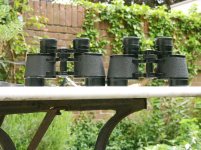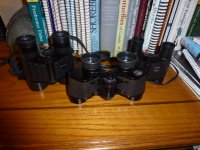james holdsworth
Consulting Biologist
I recently acquired three new Zeiss bins, at least new to me. Here is a brief review of all three....
Zeiss 8x30B Oberkochen - near mint, almost unmarked, this seems a late version [serial #935XXX] marked ''made in west germany'' and lug attachments on the body rather than the hinge.
Jewel-like build quality, absolutely beautiful fit and finish and appearance, tiny for a 8x30, nestles nicely in the palm of your hand.
The view is superb for an older porro. Wonderful sharpness, good contrast, fairly wide field, only a trace of warmth to the colour cast, great 3D view and sense of depth. Big sweetspot with very good edges. Transmission [as would be expected] isn't great, probably in the 75-80% range, but the image is gorgeous in most lighting conditions. Almost no CA. Immensely satisfying to look through, handle and look at - could very well become one of my all-time favourites.
I'm not likely to lug these jewels into the field much but they are very nice just sitting on a shelf over my desk, where I can look at their Zeiss-ness ;]
Zeiss 8x30 BGAT*P Dialyt - I have owned a non P of this model for awhile and dismissed the whole series as ''pretty average'' based on this non P. So, trading up to this P version was a revelation, as this model doesn't seem to get much love. This version seems a late issue as well, with coatings that have an FL-like magenta hue.
To me, the view is on par with my 7x42 BGAT*P - wonderfully sharp, contrasty with a huge sweetspot and very minimal edge softness, nice wide field and minimal distortion. Head-to-head, the 8x30 appeared a hair sharper and a tad more contrasty than the 7x42 - maybe due to newer coatings. Also appeared more colour neutral [coolish] than the slightly warm 7x42. Transmission seems very good, and would look to be close to 90%. Almost zero CA [a big problem for me], even at the edge of the field - equalling my FL and surpassing lots of other current alphas in this regard. Lower lateral colour than the FL. The P version is such a jump up from the non P that they hardly seem the same model.
I was in the market for a good 8x32 for fieldwork, and was looking at FL's but this 8x30 is so good I may just have found my answer.
Zeiss 8x20 BGAT*P Dialyt - I also owned a non P of this model and was completely underwhelmed with its performance - tons of distortion, tiny sweetspot, dim and pretty much undeserving of the Zeiss name. I kept it only for its collectability. The P version seems quite rare - I have only ever seen two for sale on the bay and elsewhere.
The P is loads better, although I must admit to hating most every compact I have ever tried. Much bigger sweetspot, flatter field, brighter and sharper - better in most every way. Still, this bin is a boutique version, and is most unlikely to find their way into the field for serious birding. Seems a great bin for the pocket, for travel or fishing or the like.
Anyway, thought I would share my thoughts on these three.....
Zeiss 8x30B Oberkochen - near mint, almost unmarked, this seems a late version [serial #935XXX] marked ''made in west germany'' and lug attachments on the body rather than the hinge.
Jewel-like build quality, absolutely beautiful fit and finish and appearance, tiny for a 8x30, nestles nicely in the palm of your hand.
The view is superb for an older porro. Wonderful sharpness, good contrast, fairly wide field, only a trace of warmth to the colour cast, great 3D view and sense of depth. Big sweetspot with very good edges. Transmission [as would be expected] isn't great, probably in the 75-80% range, but the image is gorgeous in most lighting conditions. Almost no CA. Immensely satisfying to look through, handle and look at - could very well become one of my all-time favourites.
I'm not likely to lug these jewels into the field much but they are very nice just sitting on a shelf over my desk, where I can look at their Zeiss-ness ;]
Zeiss 8x30 BGAT*P Dialyt - I have owned a non P of this model for awhile and dismissed the whole series as ''pretty average'' based on this non P. So, trading up to this P version was a revelation, as this model doesn't seem to get much love. This version seems a late issue as well, with coatings that have an FL-like magenta hue.
To me, the view is on par with my 7x42 BGAT*P - wonderfully sharp, contrasty with a huge sweetspot and very minimal edge softness, nice wide field and minimal distortion. Head-to-head, the 8x30 appeared a hair sharper and a tad more contrasty than the 7x42 - maybe due to newer coatings. Also appeared more colour neutral [coolish] than the slightly warm 7x42. Transmission seems very good, and would look to be close to 90%. Almost zero CA [a big problem for me], even at the edge of the field - equalling my FL and surpassing lots of other current alphas in this regard. Lower lateral colour than the FL. The P version is such a jump up from the non P that they hardly seem the same model.
I was in the market for a good 8x32 for fieldwork, and was looking at FL's but this 8x30 is so good I may just have found my answer.
Zeiss 8x20 BGAT*P Dialyt - I also owned a non P of this model and was completely underwhelmed with its performance - tons of distortion, tiny sweetspot, dim and pretty much undeserving of the Zeiss name. I kept it only for its collectability. The P version seems quite rare - I have only ever seen two for sale on the bay and elsewhere.
The P is loads better, although I must admit to hating most every compact I have ever tried. Much bigger sweetspot, flatter field, brighter and sharper - better in most every way. Still, this bin is a boutique version, and is most unlikely to find their way into the field for serious birding. Seems a great bin for the pocket, for travel or fishing or the like.
Anyway, thought I would share my thoughts on these three.....
Last edited:






